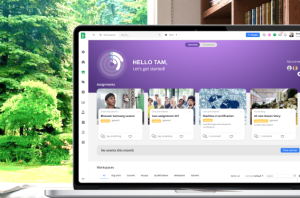How to make managers people managers, Hold managers accountable, Lead by example, Make learning visible, and Offer opportunities for cross-functional projects.
When motivation is low, even the simplest learning tasks can seem impossible. The desire to do well fades, leaving employees feeling tired and uninterested. Training completion dates become more intimidating, and learning new skills loses appeal. As a result, focus weakens, and retention of information declines.
And if that’s not enough, demotivation can create a ripple effect, affecting team dynamics and your company’s bottom line.
Learn how to foster employee motivation for learning. This blog post is the second in our series aimed at inspiring learners to increase their knowledge and skills. In the previous blog post, we explained why motivation is essential and listed five strategies for unlocking an employee’s full potential.
Now, we’ll uncover five further actionable tips to add to your kitbag for increasing AND sustaining employee motivation for learning.
The subtle difference between increasing and maintaining motivation for learning
When it comes to employee learning and development (L&D), understanding the difference between increasing and maintaining motivation lies in focus and duration.
Increasing motivation is about sparking enthusiasm and drive to achieve goals. This involves setting inspiring goals, offering incentives, such as bonuses and reward programmes, and creating a supportive environment.
By contrast, maintaining motivation involves keeping that enthusiasm going over time. It needs ongoing efforts like regular support, fostering a positive culture, and ensuring your people have what they need to stay engaged.Understanding and addressing both elements ensures a comprehensive approach to creating a democratic learning environment.
Learner motivation: Identifying the barriers
Understanding why employees lack motivation, rather than just trying to fix the surface-level problems, helps you see the bigger picture. By taking proactive steps to tackle the real issues holding your people back and recognising and understanding the barriers to learning, you can develop targeted interventions to tackle and also create a more motivated and engaged workforce.
Let’s start by looking at sustainability. While sparking initial enthusiasm is crucial, sustaining that motivation over time ensures long-term success. Focusing solely on increasing motivation without considering how to maintain it risks losing momentum and failing to achieve lasting results.
Picture this.
A manufacturing company saw a decline in employee motivation and engagement. Departmental managers noted disengagement during meetings and minimal participation in discussions or learning activities.
Instead of superficial fixes like occasional team-building or generic rewards, the company looked into the root causes of the problem with a range of employee listening strategies.
By addressing underlying issues and striving to re-engage and motivate their team, the company integrates learning into work initiatives, such as assigning learning tasks as part of regular duties and fostering knowledge-sharing during meetings.
This resulted in a significant shift within the company as team members began actively seeking opportunities for skill development and knowledge-sharing, leading to a culture of continuous learning and innovation.
Secondly, a lack of autonomy or control over the learning process can impact employee motivation for learning.
When employees feel they have no say in what or how they learn, it can lead to disinterest and disengagement. Additionally, limited autonomy can hinder their ability to personalise their learning experience. As a result, staff members may see learning as a chore rather than an opportunity for growth and development.
Organisations can boost motivation and engagement by empowering employees to be accountable for their education and training and take ownership of their development.
Thirdly, a lack of consistency can impact motivation for learning. For example, if a company frequently changes its learning platform or fails to follow through on promised opportunities for skill development, employees may become discouraged and disengaged.
Finally, limited access to relevant and engaging learning resources can make upskilling or reskilling almost impossible. For instance, if a company offers only outdated training materials or restricts access to online courses, employees may struggle to keep up with industry trends and advancements. Similarly, employees navigating complex and outdated learning platforms to find relevant content may feel frustrated and unmotivated to engage in further learning.
Cue Blossom!
Blossom is a comprehensive learning experience platform (LXP) for building a robust, innovative, and effective organisation. Customisable tools make learning enjoyable and educational, and intuitive portals engage and empower individuals.
Our LXP features advanced personalisation tools that enhance engagement. Personalised learning pathways recommend content and courses tailored to individuals’ skills and career development interests, and smart AI technologies recommend learning events based on skill level or role.

“Blossom LMS really helped us meet the training needs of our team. Its sophisticated functions really help us deliver personalised training around our hospital staff’s busy schedules and 24/7 shift patterns, “ says Shai Ashkenazi, Head of Training & Development at RAMBAM Health Care Campus. “Now, 90% of our 6000 employees are accessing training from anywhere at any time on any device.”
How to increase and maintain employee motivation
There’s no doubt about the significant role L&D plays in organisational success. However, although organisations grasp the importance of L&D, they often need help identifying the most crucial areas for training and development. For example, while having skilled and knowledgeable employees is beneficial, their knowledge may only be practically applicable if they learn the right thing.
Suppose we take a healthcare organisation that acknowledges the vital role of L&D in improving patient care and operational efficiency. In that case, it needs to pinpoint the most crucial areas for training and development. While its staff may have clinical expertise, they must gain the essential communication skills necessary for effective patient interactions. Without targeted training in communication and empathy, the organisation has issues with patient satisfaction and quality of care.
If staff members are trained extensively in administrative tasks rather than those directly related to patient care and communication, their motivation to learn may wane as they fail to see the direct impact on their day-to-day responsibilities.
By partnering with other teams, stakeholders, and learners, you can understand what inspires, motivates, and sustains a skills-based organisation.
Here are a few ways to increase and maintain employee motivation for learning.
1. Make managers people managers
Effective people management is more than delegating and overseeing tasks. It involves actively listening to employees, providing support and guidance, and recognising their strengths and contributions. When employees get the backing of their managers, they are more likely to feel motivated and engaged in their learning. It’s hardly surprising that helping employees develop their careers has gained traction over the past year–climbing from the ninth to the fourth priority in LinkedIn’s 2024 Workplace Learning Reports top five focus areas for L&D.
When managers prioritise relationship building and invest in their team’s development, it sets a positive example for the rest of the organisation. According to Gallup, employees tend to be 3.5 times more engaged when managers hold weekly meetings to review progress.
L&D can support managers to be highly effective people managers–boosting engagement and enthusiasm for learning by:
- Offering leadership development programmes. Design leadership development programmes specifically tailored to help managers enhance their people management skills, such as conflict resolution, performance management, and employee motivation techniques.
- Implementing 360-degree feedback assessments. Introduce 360-degree feedback assessments to gather insights from employees, peers, and supervisors about a manager’s effectiveness in people management. This feedback can help managers identify areas for improvement and increase their own motivation for learning new skills.
- Prioritising relationship building. Help people managers invest in their team’s development by maintaining a human first and professional second approach. Senior managers can build trust and rapport with their team by sharing stories about their learning journeys, inspiring them to take on new challenges.
2. Hold managers accountable
Set expectations with employee skill development by holding managers accountable. Send a strong message that L&D initiatives are not just a nice-to-have but a must-have, supported by leadership. This commitment from management encourages employees to invest time and effort into their learning, knowing that it is valued and supported.
Managers who are accountable are more inclined to offer guidance and support to employees in their learning journey. The assurance that managers are committed to growth can enhance employees’ confidence and motivation to embrace new challenges and acquire fresh skills.
How can accountable managers understand learner engagement and what motivates their employees to pursue additional training?
Well, first of all, robust data and analytics provide comprehensive insights into employees’ participation, progress, and performance in training programmes. This data allows managers to identify trends, patterns, and areas for improvement, helping to tailor learning experiences to meet their team’s needs and preferences better,

Regular feedback from employees can offer valuable insights into their motivations and ways to boost their engagement. For example, learners might suggest additional topics or skills they want to learn.
Armed with this knowledge, managers are accountable and boost employee motivation for learning by:
- Leveraging LXP software. Blossom’s manager dashboard makes workforce learning and performance data more visual, meaningful, and actionable. It consolidates all employee information in one place, allowing you to see the impact of L&D initiatives, such as the percentage of internal promotions or time to competency.
The dashboard provides complete visibility, holding managers accountable for their team’s education and training success. With clear metrics and insights readily available, managers are encouraged to proactively support their team’s growth and ensure L&D initiatives are aligned with broader company objectives.
By leveraging data and feedback, managers can gain a deeper understanding of L&D impact, learner engagement, aspirations, and motivation. This will allow them to monitor, measure, and optimise their team’s learning and performance.
3. Lead by example
Leaders who lead by example build trust and credibility with their team members. When leaders show consistency between their words and actions, employees are more receptive to their guidance and recommendations for learning.
Plus, when learners see their leaders actively engaged in L&D activities, it inspires them to follow suit. It validates the importance of learning and sends a message that learning is not just a requirement but a valued and essential part of personal and professional development.
- “Blossom has changed the way we learn – it has elevated our capabilities to share our knowledge and qualify our mentors and employees. It has also organised their method of learning and appetite for learning. It has had a positive impact on every user in the organisation.” –Liat Segal, HR Manager and Manager of Learning at Perach
Microsoft showcases the importance of leading by example. The brand fosters a culture where everyone is encouraged to learn and grow continuously, from the CEO to every employee. This inspires everyone to embrace development as a continuous process regardless of pay scale.
Lead by example by:
- Communicating openly and transparently about the importance of education and training. Share your own learning goals, challenges, and successes to foster a culture of openness and growth.
- Actively participating in training programmes, workshops, and learning activities alongside your team members. Show enthusiasm and engagement to inspire them to do the same.
- Facilitating discussions and knowledge-sharing sessions within your team to encourage collaborative learning. Lead by example by actively participating in these discussions and sharing your own insights and experiences.
4. Make learning visible
Given that only 5% of business leaders say they have the necessary capabilities to stay competitive, making learning visible to all employees, regardless of location, can secure your company’s competitive edge now and in the future.
When employees aren’t aware of available development opportunities, they miss chances for growth and innovation. This can lead to being stuck in their roles, affecting performance and goal achievement. Consequently, team members feel undervalued and disengaged, resulting in higher turnover rates and decreased morale.
Not only that but if learning isn’t visible, it can harm your reputation as an employer. Prospective hires may view your company as stagnant, deterring top talent.
Provide regular updates on available learning resources to make training initiatives visible to all. Blossom’s intuitive and user-friendly platform design makes it easy for employees to see available learning events–personalised to their unique development needs and workflows.

Nurture and support talent pipelines with features for employee evaluation, coaching, skills assessment, and occupation-matching tools. These resources help your people identify, train for, and achieve career development opportunities.
Communication and collaboration features like discussion forums, social learning tools, and group projects encourage knowledge-sharing, lively chat, and employee collaboration.
Leverage software to empower and inspire users to take ownership of their career development. Make learning visible with personalisation, collaboration, and skills-matching capabilities to support self-directed learning and discovery.
5. Offer opportunities for cross-functional projects
When colleagues work on different projects with people from various departments, they share different views, broaden their skills, and learn from each other. This helps them solve problems better by igniting curiosity and developing good communication skills.
For instance, let’s imagine a marketing assistant called Ivan. Typically, the assistant solely works on marketing campaigns. However, their manager assigns Ivan to a cross-functional project with the product development team. Through this project, Ivan learns about product creativity and market research. He collaborates with engineers and designers, gaining insights into different business functions. This hands-on experience broadens his skill set and sparks his interest in learning more about product development. He also seeks training opportunities in advanced market research and customer behaviour.
Cross-collaboration projects motivate employees to collaborate and enhance skills. Use technologies like personal channels and a centralised knowledge hub to expand skills and provide cross-functional project opportunities. These tools act as repositories of information, resources, and best practices. Employees can access a centralised knowledge hub to explore various materials related to their role or team, fostering self-directed learning by proactively seeking relevant information for current projects or interests.
Plus, having access to a centralised hub promotes continuous learning by making it easier for different departmental employees to stay updated on industry trends, product guides, and other important information.
Increase and sustain learner motivation with Blossom
Blossom is a powerful solution to increase and sustain learner motivation in any educational or professional setting. By leveraging its intuitive interface, personalised learning paths, and interactive features, you can empower learners to take ownership of their learning journey.
Implement the five practical tips we’ve shared here to keep your team members motivated to learn and ensure that education and training remain exciting and rewarding experiences.Motivate your workforce for learning and enhance the effectiveness of your L&D initiatives. Schedule a demo to learn more.








